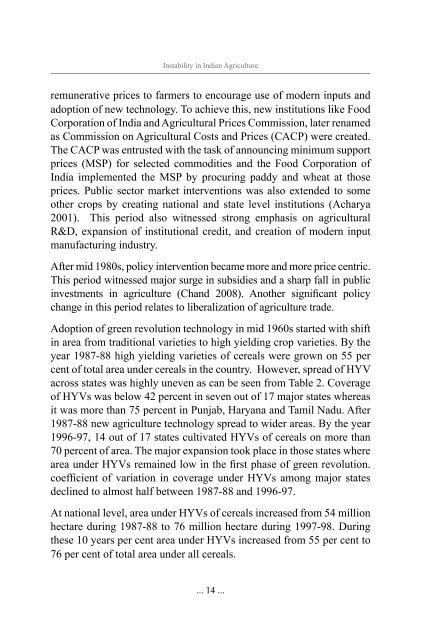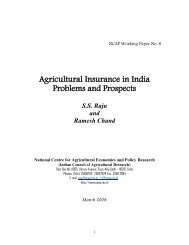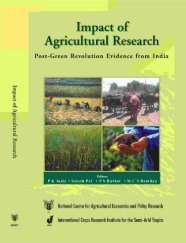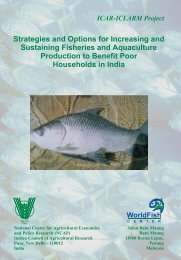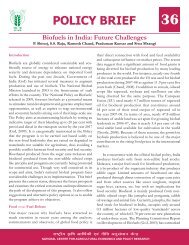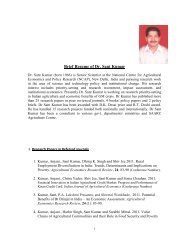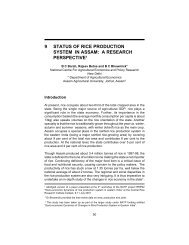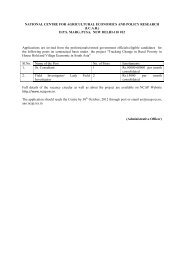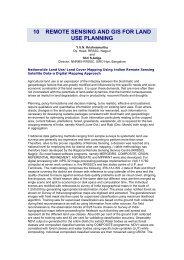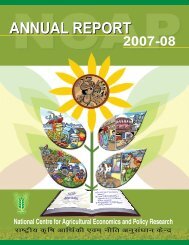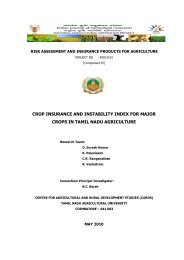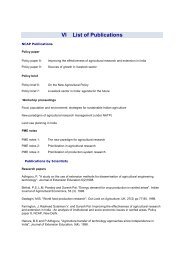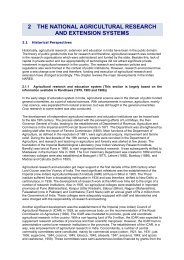Instability in Indian Agriculture - NCAP
Instability in Indian Agriculture - NCAP
Instability in Indian Agriculture - NCAP
Create successful ePaper yourself
Turn your PDF publications into a flip-book with our unique Google optimized e-Paper software.
<strong>Instability</strong> <strong>in</strong> <strong>Indian</strong> <strong>Agriculture</strong><br />
remunerative prices to farmers to encourage use of modern <strong>in</strong>puts and<br />
adoption of new technology. To achieve this, new <strong>in</strong>stitutions like Food<br />
Corporation of India and Agricultural Prices Commission, later renamed<br />
as Commission on Agricultural Costs and Prices (CACP) were created.<br />
The CACP was entrusted with the task of announc<strong>in</strong>g m<strong>in</strong>imum support<br />
prices (MSP) for selected commodities and the Food Corporation of<br />
India implemented the MSP by procur<strong>in</strong>g paddy and wheat at those<br />
prices. Public sector market <strong>in</strong>terventions was also extended to some<br />
other crops by creat<strong>in</strong>g national and state level <strong>in</strong>stitutions (Acharya<br />
2001). This period also witnessed strong emphasis on agricultural<br />
R&D, expansion of <strong>in</strong>stitutional credit, and creation of modern <strong>in</strong>put<br />
manufactur<strong>in</strong>g <strong>in</strong>dustry.<br />
After mid 1980s, policy <strong>in</strong>tervention became more and more price centric.<br />
This period witnessed major surge <strong>in</strong> subsidies and a sharp fall <strong>in</strong> public<br />
<strong>in</strong>vestments <strong>in</strong> agriculture (Chand 2008). Another significant policy<br />
change <strong>in</strong> this period relates to liberalization of agriculture trade.<br />
Adoption of green revolution technology <strong>in</strong> mid 1960s started with shift<br />
<strong>in</strong> area from traditional varieties to high yield<strong>in</strong>g crop varieties. By the<br />
year 1987-88 high yield<strong>in</strong>g varieties of cereals were grown on 55 per<br />
cent of total area under cereals <strong>in</strong> the country. However, spread of HYV<br />
across states was highly uneven as can be seen from Table 2. Coverage<br />
of HYVs was below 42 percent <strong>in</strong> seven out of 17 major states whereas<br />
it was more than 75 percent <strong>in</strong> Punjab, Haryana and Tamil Nadu. After<br />
1987-88 new agriculture technology spread to wider areas. By the year<br />
1996-97, 14 out of 17 states cultivated HYVs of cereals on more than<br />
70 percent of area. The major expansion took place <strong>in</strong> those states where<br />
area under HYVs rema<strong>in</strong>ed low <strong>in</strong> the first phase of green revolution.<br />
coefficient of variation <strong>in</strong> coverage under HYVs among major states<br />
decl<strong>in</strong>ed to almost half between 1987-88 and 1996-97.<br />
At national level, area under HYVs of cereals <strong>in</strong>creased from 54 million<br />
hectare dur<strong>in</strong>g 1987-88 to 76 million hectare dur<strong>in</strong>g 1997-98. Dur<strong>in</strong>g<br />
these 10 years per cent area under HYVs <strong>in</strong>creased from 55 per cent to<br />
76 per cent of total area under all cereals.<br />
... 14 ...


